There are many very important skills in volleyball. Digging the hard-driven ball is definitely on that list. Learning to dig is an important skill for everyone on the team. A successful dig keeps your team in the rally and gives you another chance to make the point.
What is a dig in volleyball? A dig is a defensive bump that keeps the ball from hitting the floor when it’s sent to your side of the court with an offensive attack, usually a spike. Anyone can and should learn to dig, so keep reading to learn the techniques to improve your digging.
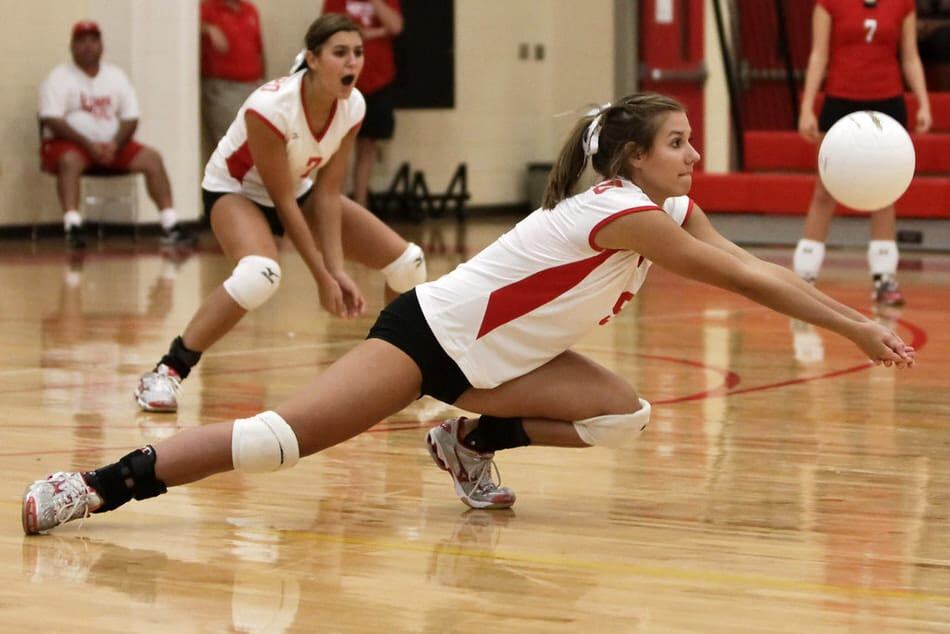
Lessons For Solid Digging
Who Has It?
As your opponents are developing their attack, you need to be in position to cover the zone of your defense according to what your coach has laid out. Adjust your positioning when you see your blockers go up and as you see the hitter make their approach.
The direction of the ball should be predictable most of the time if you watch the hitter’s body motion, their hips and shoulders (which way are they facing?) and their hitting shoulder. You have to guard your portion of the court, so be ready to intercept that ball as it comes into your area.
Of course, hitters can make some last-second changes and decide to tip or float a hit instead of a typical topspin spike, but the majority of the time, you can gauge where the ball is going to go ahead of time and be in the right zone.
Even if you think the ball is headed somewhere else, you need to expect the ball. Sometimes you will think it’s going somewhere else and you’ll be wrong. Other times, by being ready, you will be in a good position if one of your teammates needs help after barely making a dig playable.
Your Defensive Stance
Are you ready for what’s coming? That player on the other side of the net is about to do their best to unleash a laser to the floor.
You should be in your athletic stance. Your feet should be twice your shoulder-width apart. You need to have your knees bent and be bending over at the waist.
Your shoulders should be over your knees and your weight should be on your toes. Being on your toes keeps you light on your feet. If your weight is on your heels, you’re likely to be caught off-guard.
You will often see volleyball players reach down and brush the floor with a fingertip to make sure they are low enough. This is a habit they pick up in practice, you shouldn’t really be doing this in a game.
The point is, you should have your feet far enough apart and your knees bent enough that you can reach down and just barely touch the floor. Remember, it’s always easier to raise up for a higher ball than to get down low at the last second.
This makes you compact and ready to react. Your arms should be bent and out to the sides, outside of your knees. As that player is making contact you need to be able to spring into action, moving in whichever direction you have to adjust.
What Are You Watching?
On defense, you need to be watching the entire time the other team has the ball. They are giving you information step by step. Watch as the pass is made to their setter.
Watching how the setter is given the ball may narrow the options they have – you may be able to tell their play is falling apart. As the setter is playing the ball, watch their body.
Setters will often have “tells” that let you know what they are going to do with the ball.
If they take the ball far in front of them, they may be trying to push the ball the further distance to their outside hitter. If they take the ball almost straight above their head, expect a backset. In between those 2 extremes, there’s a motion that looks like they’re setting the middle hitter.
By watching the setter closely you can often catch them when they try to go for a setter’s dump.
Next, as soon as the ball leaves the setter’s hands, you should know which hitter is getting the ball. Locate them and begin to gather information about how they are approaching.
Will it be a quick attack or a traditional full approach? Are they going to hit
As your blockers make their move, you should be able to tell if they will be able to eliminate some of the field that you have to protect. Think about your blockers like a shield.
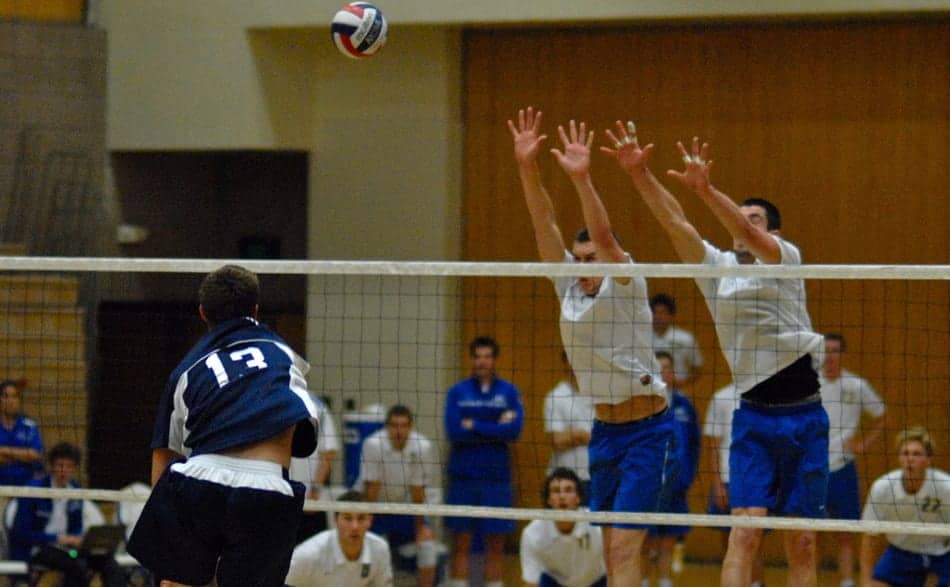
If you know someone on the other side is having to hit around that shield, you as the defender can focus on the area that the shield does not protect. If you are watching closely, you can be close to the spot the ball will come before it’s even hit.
Get To The Ball
If you’ve done your work up until now, you’re close, you just have to make the dig. If you’ve watched closely and narrowed down the possibilities of where they are going to hit the ball, and you’re down low and ready with your arms at your sides, now you have to MOVE like lightning.
Adjust the last few feet one way or another and get as safe a pass on that ball as you can.
You have to be ready to dive, but often you won’t have to go to that extreme. Many dives can be eliminated by moving your feet instantly when you realize where the ball is going.
By being low, you can often just take a quick step forward or to the side and be in a strong passing position. During this part of the dig, you cannot hesitate. You have to go with your instinct and go for the ball.
Make A Pass, Not Just A Bump
It’s critical that you keep the ball in play to keep your team alive. Your first goal is to keep the ball from hitting the floor, no matter what it takes.
But, is that what we’re really going for? You want to WIN this game, not just survive through the points. Your team needs a good pass out of this dig, not just a bump. Sending a bump randomly up in the air puts your team in a weak position as you try to send an attack.
As you are making your dig, here are some things you have to do to produce a solid pass
- Produce a quality platform. The plane that you form with your arms may have to be at awkward angles or out of your comfort zone, but do everything you can to straighten your elbows out, keep your hands together properly and not swing your arms. When the ball is to your side, you need to bring your arms together at that side. So if the ball is coming off to your left, your left arm is already over there, bring your right arm out to meet it instead of joining them together in the middle and swinging your arms out together.
- Square your platform to your target. Remember where your setter is supposed to receive the ball? Whether she is there at this moment or not, your job is to deliver a quality pass to that location.
So adjust the angle of your platform to make the ball naturally bounce toward that target. - Break the power if necessary. Sometimes your opponents are simply bringing too much firepower! If you hold your arms rock solid for a pass, the ball is going to go too far and out of control. When this is happening, you have to let your arms give a little to break the power of the hit. My coach used to say “let the spike break your arms a little.” You don’t want your arms to be limp, but you are letting your arms take some of the energy out of the momentum of the ball.
- One arm is better than nothing. So we want a solid pass, but you may have to resort to stretching and using one arm in an emergency if you can’t get both hands on it. Make a strong fist and reach out and use either your fist or forearm to go for a one-handed pass. If you use your fist, hit it just like you would an underhand serve, only with very little swing.
When And How To Dive
In the heat of the action, you may need to dive. Very few people enjoy diving, mainly because it’s tough to do without discomfort or pain. Everyone should practice diving in practice so that they don’t hurt themselves in gameplay.
When the ball is too far to reach and you have to dive, start by taking as many steps as you can toward the ball. When you know you won’t be able to get there in time, use your last step to propel your dive.
You want to lower your body so that you’re not falling hard to the floor. As your body drops, you use that last step to drive forward and make
You want to absorb your landing on the floor with your chest and finish with a slide. Avoid landing hard on your hip, your knees or your elbows.
Whenever you dive you want to keep your head up. This helps you maintain your sight of the ball throughout the action but also keeps you from smacking your chin or face on a knee or even worse, the floor.
What If It’s Too Far To Reach?
Sometimes you can’t get to the ball fast enough and whether you’re playing on the sand or indoors, you’re going to have to dive for it.
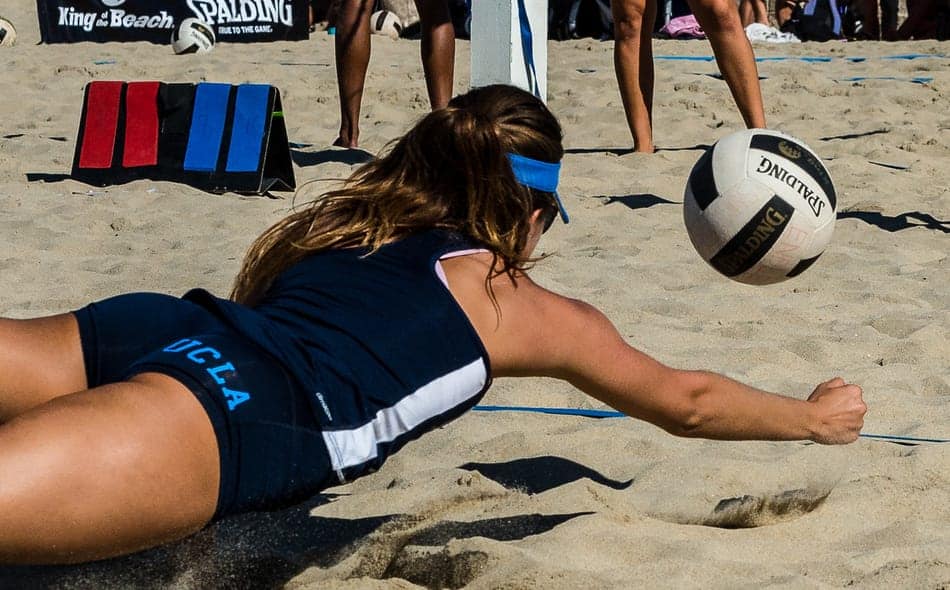
If the ball is too far for you to reach even with a dive, it’s time for a one-armed lunge or if you’re diving forward, a pancake. Lunging with one arm is not ideal, but sometimes you’re just scrambling to keep the ball in play.
To learn more about perfecting your pancake technique, check out our post called What is a Pancake in Volleyball?
How To Dig Without It Hurting
Volleyball is an incredibly fun sport, but one of the things players dislike the most is the pain that comes from serve recieve or digging. One answer for this is just that repetition will help your arms get used to the impact, but that’s not very encouraging is it?
Make sure that you’re using the sides and undersides of your forearms. You never want to be using the tops of your forearms for your platform. Using the tops will give you crazy unpredictable bounces and hurt far more!
Be consistent in taking the ball on your forearms, not your wrists or hands. Your meaty part of your forearm can take the abuse a lot better than the joints involved in your wrists and hands.
I enjoy wearing long sleeves in practice. Personally, I enjoy wearing them for the control it gives me with my passing, but it does soften the blow. While your team may have jerseys that are short-sleeved, you can ask if it’s against the rules to wear a long sleeve white T-shirt underneath during games.
If after playing you just can’t get used to the impact, you may want to consider getting some arm sleeves. Players shouldn’t get these immediately as a beginner, but if the discomfort is enough that you would just give up the sport otherwise, time to give compression sleeves a try.
They do have the extra benefit of helping your arms to slide when you do end up diving so you won’t skin your elbows.
**If your arms are getting worse after you’ve stopped playing or if they don’t respond to rest, you may need to see your healthcare provider.**
What Is An Overhand Dig?
An overhand dig is a last-second move to react to a high hard-driven ball. The player uses a firm overhand palm strike to send the ball back toward the net, helping to keep their team in the game.
In some cases, you’re going to be ready for a hard-driven ball coming toward the floor and suddenly be surprised when the ball comes a lot higher. This can happen because the hitter didn’t snap their wrist and the ball was a “line drive”. Other times it may be that the ball ricochets off the block. This can also occur when you’ve covered too far forward in the court and the hitter sends it deep.
If you assess the situation and think it’s going to stay inbounds, you have to play it extremely quick and much higher than you expected. This is when you would use an overhand dig.
Although it looks like a set to beginners, you are not trying to set the ball. It’s important you understand this or you can really hurt your fingers. You are using strong, firm hands to bounce the ball toward your setter.
If you can, you want to lean into this overhand dig with your shoulders forward. The ball should make a palm-slapping kind of sound.
Another Tip To Take Your Digging To The Next Level
In most games, you are going to have plenty of time to do something ahead of time that can give you a better chance during the game. That’s right, study the opposition!
During earlier games (in tournaments or multi-game matches) or during warm-ups, you should identify your best opposing hitters. Pick a couple of them out and watch them, like really pay attention to how they hit.
Where do they like to hit from? Do they like to hit line or angle? Do they call for the same set every time or mix it up? Do they give up on the set easily and go for a tip?
If you watch closely, you can gain valuable information from their tendencies that may help during the most intense part of the game.
When you do find something about a hitter that’s worth remembering, you need to find a way to remember that later in the games. Come up with a nickname phrase for them. Make it something that you’ll remember and keeps that info fresh.
Make up a name, use their number, or pick out a distinguishing feature about them and pair that up with their trait or habit.
A few examples might be:
“Number 9 likes to hit line” or
“Blonde middle is a quick killer” or
“Sally Sue doesn’t jump as high when she’s going to tip”
When you see situations involving these players in the game, be ready for them to play out. Don’t overcommit to what you think will happen, but you’ll find yourself leaning just a little ahead of time, one step ahead.
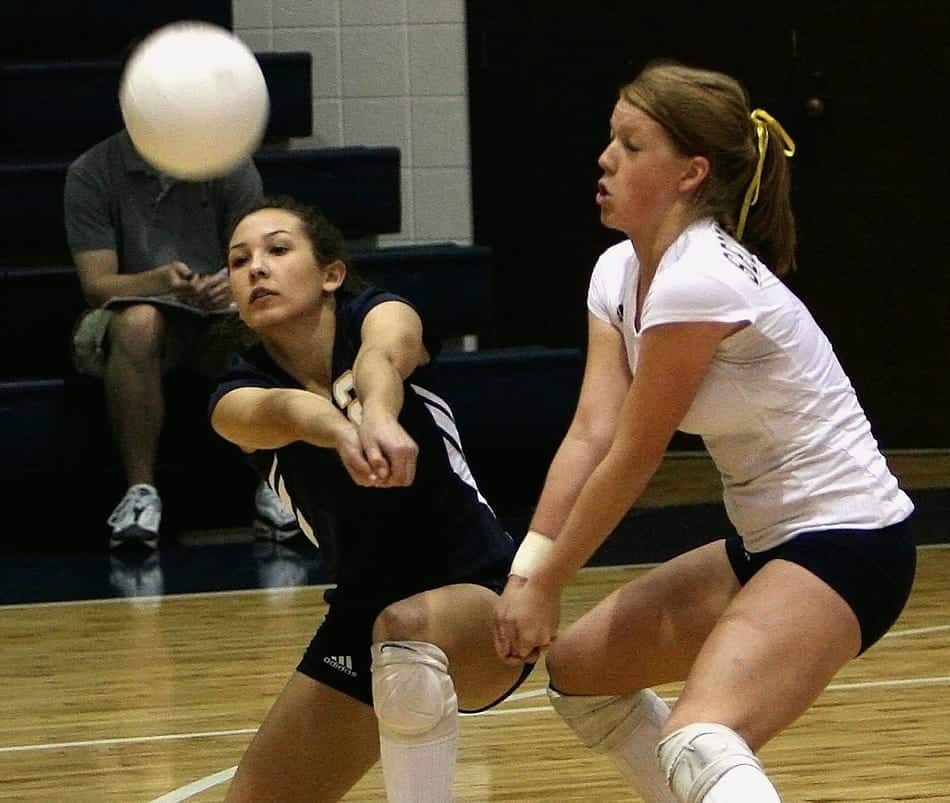
Digging Drills
Digging To Catch (Great beginner drill) Bonus – You don’t need a court for this drill!
For this drill, the coach should prepare by taping a 4’X4’ box somewhere on the floor. Then tape a bigger box surrounding that box, about 8’X8’ to create almost a bullseye kind of target.
The players will start in a line far 8 to 10 feet away from the box. The idea is that they are digging from the back of the court and aiming for a target area that the setter can work with.
When the coach hits, the digger must dig the ball in a way that they can catch their own dig as close to the target as possible. So there are 4 levels of consequence in this game.
Catch their own dig in the small box = 3 points.
Catch their dig in the big box = 2 points.
Catch their dig outside the box areas = 1 point.
Can’t catch their dig = out!
Play can progress until a player reaches a specific amount of points or until everyone is knocked out.
Coaches should reinforce the idea of getting enough height on their dig that their teammate can make a solid play on the ball.
Digging The Wall (Solo Drill)
In this drill you toss the ball to the wall, then hit it and then dig your rebound. At first don’t hit the ball very hard, it’s going to be challenging to pick up the rebound, but as you get the hang of it, challenge yourself. Vary the speed, angle, and height of your tosses and hits.
The Endless Dig
For this drill there needs to be 5 people:
1 setter playing the middle front
2 hitters playing in outside hitting positions
2 defenders playing the back row
The coach may be one of the hitters to guide the drill. The hitters are in the location to have the setter practice setting to those spots, but they are hitting to the defenders on the same side of the court, hitting at 75% speed. The whole drill takes place on one side of the court, so your team can split in half and replicate this on the other side.
The play begins with a hitter hitting toward the defenders, who dig to the setter in the middle. The setter may choose either hitter to set.
The defenders have to continually adjust back and forth and decide who is getting it. If the digs are strong and the sets are decent, this play just runs continuously.
Dig, Tip, Chase
In this drill, players line up at the endline. The coach or hitter will be feeding the ball with their back to the net on the same side of the court.
The feeder begins by hitting them a ball to dig, the player must return a playable pass. The hitter then tips the ball, making the player come in close to dig another playable pass.
Finally, the hitter simulates a mishit and send the ball wide on either side, which the player must chase to save and try to send the ball back into play.
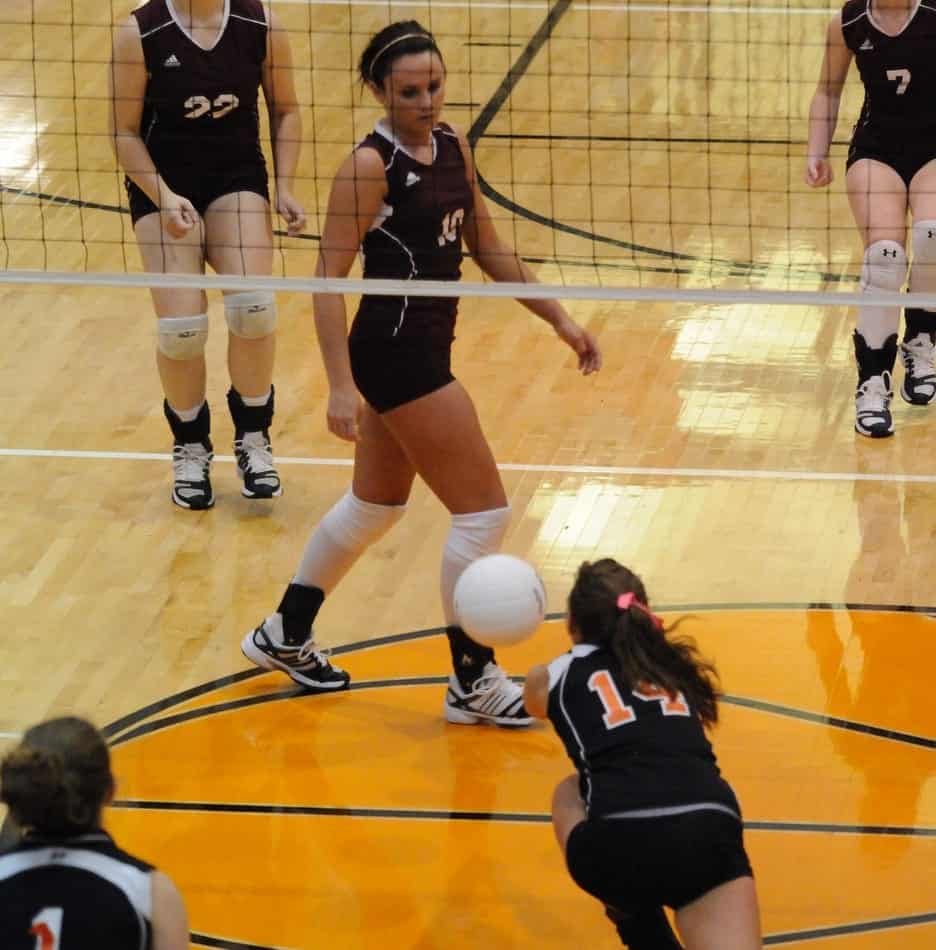
Rapid Fire Digging
In this drill you will use two hitter boxes if you have them, set on the same side of the court in position 2 and 4, just behind the attack line. The defensive players will split up into 2 lines deep on the other side of the court.
When the coach says go, the hitters drive a hard ball for the diggers to get up. Try to have a high-speed tempo, use as many shaggers as possible to keep it moving.
Progression – Use your libero(s) and/or defensive specialists to play in between the two lines of defensive players. Have the hitters alternate so that the libero has to play every ball. Again, keep the tempo high so players are having to make quick decisions and get as many reps in as possible.
Related Questions
What Is A Down Ball In Volleyball?
A down ball in volleyball is when someone attacks the ball from a standing position instead of jumping. This is usually when someone on the back row hits the ball. You can remember this by thinking about how the player stayed down instead of jumping. Another way to think of it is that defenders will usually not block these shots, the blockers will stay down.
What Is The Difference Between A Libero And A Defensive Specialist?
A libero and a defensive specialist share many similarities. The differences between the libero and the defensive specialist are: the libero is designated ahead of time to only play the back row for the entire game or tournament, the libero wears a different jersey to signify that role to the referees, and the libero may substitute an unlimited amount of times at any stoppage of play with any player on the back row. Many teams would consider their defensive specialist the backup for the libero should they get injured.
What Is A Kill In Volleyball?
A kill in volleyball is an attack that results in a point because it can’t be played successfully by the defense, either it hits the floor or the defense tries unsuccessfully to play it. When you hear the term “kill”, think of it as the player killed the rally, they forced an ending and won the point.
To learn more about all kinds of other volleyball terms, visit this article: Volleyball Terms, Stats, Acronyms & Abbreviations.
Photo credits:
Feature image by skeeze from Pixabay
Red & white dig image by AJ Guel on flickr.com: https://creativecommons.org/licenses/by/2.0/
Player #13 spike image by KLM volleyball on flickr.com: https://creativecommons.org/licenses/by-nd/2.0/
Beach dive image by Ernie Tyler on flickr.com: https://creativecommons.org/licenses/by/2.0/, cropped.
Double dig image by Keith Johnston from Pixabay
Player #14 dig image by Dan Morgan on flickr.com: https://creativecommons.org/licenses/by/2.0/
Recent Posts
Athletes, listen up! Do you have a closet full of old jerseys, sweatpants, and tees that you just can't seem to part with? Well, dust them off, because you're sitting on a goldmine of fashion...
You may have heard, or you may have noticed, that there's been a change to the rule about double contact in volleyball. In 2022, an experimental rule change began to be implemented, where the double...
